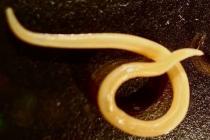Guitar fish or Gastromyzon punctulatus. Habitat: inhabits shallow rivers, streams and water bodies, including mountain ones,
with clean cool water saturated with oxygen. It mainly lives in Borneo, but also in Vietnam, China and Laos.
Appearance:
It is 6 cm in size. It has a flat translucent belly, which allows it to firmly attach itself to the surface, even with a strong current. In the lower part there is a wide mouth surrounded by small beards. Body coloration is variable: from light brown to absolutely black. Scattered across this background are yellow spots of various sizes.
Sex differences:
In females, the muzzle is rounded, in males, rectangular.
They feel best in a group of 2-4 individuals. For such a number of gastromizons, a capacity of 60 liters or more will be required. In an aquarium, it is not so much size that matters as the area of the bottom. With a lack of space, intraspecific conflicts are possible.
The soil needs loose, large flat stones are laid on it. Gastromizon moves along the bottom in jerks, from one surface to another, while trying to avoid the ground. This is explained by the fact that the fish have very delicate and sensitive abdominal skin. He mostly spends time on stones, from which he scrapes off plaque along the way.
Fish also use plants for movement, so only species with powerful roots and large leaves are suitable, for example, echinodorus, anubias.If you put different shades of soil in the aquarium, you can observe the ability of gastromizon to change color in accordance with the surface.
The water must be clean and enriched with oxygen, in connection with which it is necessary to install powerful equipment - a filter and a compressor. Gastromizon will be happy if a moderate current is created in the aquarium, natural for its natural habitats. A third of the water is changed weekly and is combined with soil cleaning.
Due to the absence of scales on the abdomen and head, gastromizon is very sensitive to chemicals and drugs, therefore, if it is necessary to treat other fish, it is better to put healthy gastromizons off for a while.
Breeding:
Cases of breeding gastromizon in captivity have not been recorded, and due to the complexity of observation in nature, there are also no data on how this happens.
Water parameters:
Hardness from 10 - 15 ° dGH, pH 6.0-7.5., Water temperature 22-25 ° C.
Nutrition:
They feed not only on dry or frozen plant-based food, but also eat moss, which eventually appears on the surface of stones and glass.
A weekly fasting day is required, systematic overeating is fraught with obesity and the death of fish.
The Indian and Pacific oceans are home to a fish that in English is called "bowmouth guitarfish" - "arched guitar fish". The fish looks like a cross between a shark and a stingray. In Latin, the fish is called Rhina ancylostoma. From the outside, it resembles an electric guitar, a stingray, and a shark. Sometimes the fish is called "shark ray".
The fish guitar lives at a depth of 90 meters, feeds on shellfish, small fish, crabs and shrimps. Shark stingray is viviparous. A female guitar fish can give birth to up to 11 fry at a time. The guitar fish tolerates captivity very well; several of its specimens are kept in large aquariums and aquariums.A female guitar fish named "Sweet Pea" lives in the aquarium in the American city of Newport. In 2014, Sweet Pea became the first guitar fish to become pregnant in captivity and gave birth to seven fry.
In its natural environment, the guitar fish has few enemies. Only the tiger shark from time to time tries to hunt shark rays. Sharp spines that grow on its back and head save the guitar fish from its teeth.
You look at it and think - it looks like a shark, but you called it a fish, you climb into an encyclopedia, and there it is generally ... ... a stingray. Twisted, however.


The guitar fish is one of the seven species of the stingray family. This marine musical instrument found its refuge in the eastern part of the Atlantic Ocean and in the Mediterranean Sea. Fans of fishing, it is better to go to the north-western part of Africa for this fish.


The British and Americans nicknamed him the guitar-fish, that is, the stingray, because of the shape of his body, so reminiscent of this musical instrument. In Australia, the stingray received the nickname - the banjo shark, and the French call it "sea violin".


This stingray leads an eerily calm lifestyle. It lies on a sandy bottom or muddy ground and does not bother anyone. Except for small fish, shellfish and small crustaceans that make up his daily diet. The stingray does not bother with unnecessary movements so much that you can easily catch it by the tail with your hands. He begins to swim only in one case - when his stomach rumbles with hunger.

Off the coast of India, guitar stingrays live in flocks and do some harm to oyster banks. They are of little importance in the local fishery of some countries, for example, in Peru, China and all the same India.
Guitar fish are ovoviviparous. The female is capable of bearing up to 10 cubs. That's probably all there is to tell about them. Due to their calm nature and non-outstanding abilities, these rays remain in the shadow of their larger and more predatory counterparts. Wait a minute, there was one instance that got famous. He was caught in fishing nets. Its length reached 3.1 m, and it weighed 227 kg.
In a number of ways, stingrays resemble sharks, but their gill openings are located on the lower surface of the body. The detachment includes two families - shark-tailed rays and rohly, or guitar.
FAMILY SHARK-TAILED SKATES (RHYNCHOBATIDAE)
In terms of body shape, the stingrays that belong here occupy, as it were, an intermediate position between typical sharks and stingrays. Their body is flattened, but its tail is almost not separated outwardly from the trunk. The snout is elongated, the pectoral fins in the posterior part are not attached to the body, and the first dorsal fin is located above the pelvic fins. They all have a two-lobed tail fin with pointed ends, very similar to the tail fin of sharks.
The family includes only two genera with several species common in tropical waters off the coast of Africa, Asia and Australia.
Shark-tailed ray(Rhynchobatus djiddensis), whose distribution area covers the warm-water regions of the Indian and western Pacific Ocean (from South Africa to the southeastern Sea of Japan), reaches a length of 3 m and a mass of 225 kg. Its main food is benthic invertebrates. Reproduction takes place by egg production. This ray has some commercial value, and in India, for example, it is readily eaten both fresh and salted.
FAMILY GUITAR, OR ROCKLEY, SKATES (RHINOBATIDAE)
The stingrays belonging to this family in the shape of the body have a certain resemblance to the string musical instrument... In England and the USA they are called the fish-guitar, in Australia - the shark-banjo, in France - the sea violin.
Guitar rays are very close to shark-tailed rays, but differ from them in the absence of a two-bladed caudal fin and dorsal fins set backward. This family includes 7 genera and about 40 species. Rokhlaya stingrays live in the tropical zone near the shores of all oceans and sometimes enter freshened estuaries.
Guitar stingrays spend their lives swimming slowly at the bottom or lying on sandy or muddy ground in which they can partially burrow. They are so inactive that they even allow them to grab their tail with their hands. During swimming, these sharks (like shark-tailed rays or saw rays) use their tail as a propeller, and not pectoral fins, as other rays do. Their food consists of small fish, crustaceans, molluscs and other benthic animals, which they gnaw with their rounded small teeth. Off the coast of India, guitar stingrays come across in flocks and do some harm to oyster banks. They are of little importance in the local fishery of some countries, for example, in India, China, Peru and in a number of other regions.
Quite common off the Atlantic coast of America spotted guitar stingray(Rhinobatos lengitinosus), reaching a length of about 75 cm. Like other guitar stingrays, it belongs to the ovoviviparous species, and the female gives birth to 6 cubs in one litter. Spotted stingray is found at a depth of 0.3 to 18 m.
Found in the Indian and Pacific Oceans Schlegel's ramp(Rhinobatos schlegeli), sometimes found in the southern part of the Sea of Japan, off the coast of Korea and Japan. It reaches a length of 87 cm and has some commercial value, since its meat is considered delicious, and its fins are very valuable for making soup. This species also inhabits coastal waters. The female brings up to ten cubs.
Gastromizon punctulatus, or guitar fish (lat.Gastromyzon punctulatus) is a freshwater fish of miniature size, belongs to the Balitorov family. Natural habitat - reservoirs of South-East Asia (Borneo). These are fast flowing rivers, mountain streams and waterfalls. Aquarium gastromizones reach 3-6 cm in length and live for 3 years. The fish that are sold in our stores are often caught in nature for further export. However, they easily adapt in captivity in conditions that are close to their natural biotope.
Quick jump to article
External characteristics
The maximum size of the fish is 7 cm. The fish is also called "guitar" because of the characteristic symmetry of the body - flat, with a flattened head. It is narrowed from below. The pectoral and pelvic fins are fan-shaped, so these fish can swim upstream. The caudal fins are few and far between. The color of the skin is black-brown with a yellow, chaotic pattern.

Sexual dimorphism is noticeable: females are larger than males, body color is not so attractive. Males are even smaller in size, but are characterized by graceful body symmetry. All fish have suckers, which are located on the abdomen. Thanks to them, they can attach to solid surfaces. The fish have no scales, the belly is transparent, the internal organs are visible through it.
See how Gastromizon Punctulate cleans the stone.
How to choose a Gastromizone for a novice aquarist? In order not to be disappointed in a pet, you need to know the rules for choosing.
- Buy from trusted sellers (preferably at a pet store with proper housing conditions).
- Choose young individuals that have not reached 3-4 cm in size. Such fish adapt faster to new conditions, do not earn severe stress. In nature, they are caught, then transported. Gastromizons are kept in cramped containers for a long time, so at first it is difficult for them to get used to the new environment.
- Do not buy fish with obvious bodily harm. When fishing with a net, or when fighting with aggressive neighbors, they can get hurt. If you notice that gastromizon swims sluggishly, does not take food, it means that it was poorly maintained. Hungry fish look emaciated, their eyes bulging.
Content rules
The gastromizones that will live in your tank may have come from Asia. For such individuals, a period of acclimatization, or quarantine, is required. Many fish quickly get used to a new home, but do not spawn in an aquarium. Adult fish (5-6 cm) will not live long due to their age, and it is more difficult for them to get used to the aquarium. At first, the fish need to be put into a separate quarantine tank so that they do not infect other fish (in case of illness).


Content is possible in a shallow reservoir with a wide bottom area. One fish requires 15 liters of water. It is advisable to buy and launch several fish at once - from 4 to 5 individuals. Gastromizons are peace-loving pets, but in a tight space, they will begin to fight for territory. Fights can occur between males, although bodily harm is unlikely to work. They should not be kept with fish large and aggressive, as well as predatory.
The aquarium gastromizon should live in conditions that resemble natural habitats. Water temperature: 20-26 о С, acidity 7.0-8.0 pH, hardness - from 10 to 15 dgH. The purity of the water is extremely important: once a week, replace 20% of the water with clean water. Install a high power filter in the aquarium.

River sand washed and treated with high temperature (boiled in boiling water or calcined in an oven) is suitable as a soil. On the bottom, you can put stones with a smooth surface - they will serve as the personal territory of the fish, which it will ennoble. Several fish can settle on one stone.
Compatibility. Feeding
Gastromizon can live in an aquarium only with peaceful species of small fish. It is important that there is enough space in the tank for everyone, otherwise conflicts will arise. Food should also be given to everyone - fish gastromizones are slow, and nimble fish can eat their portions of food in advance.
Guitar fish get along well with other species, help in cleaning the aquatic environment from vegetation and algae. Most of the time they spend on their stones, sometimes they hide behind a filter, near which there is a current, as in the natural environment. Avoid the vicinity of aquarium freshwater sharks, cichlids, large catfish, carp, arowans.
Watch the guitar fish.
This is an algae-eating fish that is specially placed in the aquarium to destroy bacterial growths of blue-green and green algae. They stick to hard surfaces and plants without damaging them. You cannot feed these fish with live food in large quantities, otherwise they will live a little. At first, in a new aquarium, they may completely refuse food, later they will begin to take it, gradually getting used to it. Starter feed is what appears on rocks and decorations.

Gastromizones eat different foods, but most of all they like slowly dissolving tablets for bottom fish, plant-based flakes. The basis of the diet is plant foods (sliced zucchini and cucumbers, lettuce). The food can be laid out on a clay plate - this way the fish will find it faster.
Also, guitar fish can be fed bloodworms, tubifex, brine shrimp, small cyclops (preferably frozen) as live food. You cannot overfeed. A fasting day can be done once a week. The fish will receive the necessary portion of food by collecting organic deposits from glasses, stones and decor.














